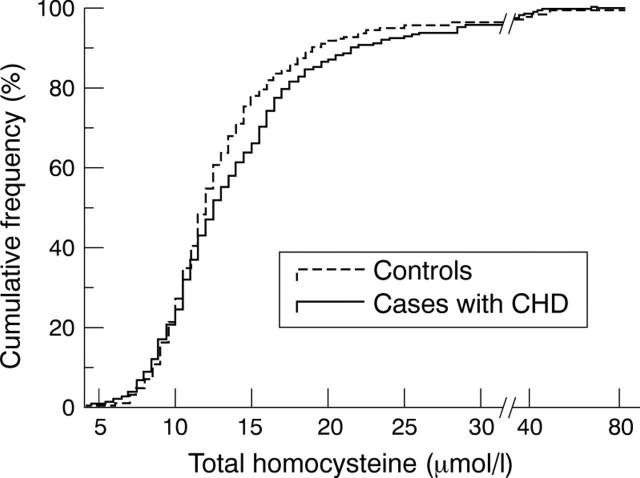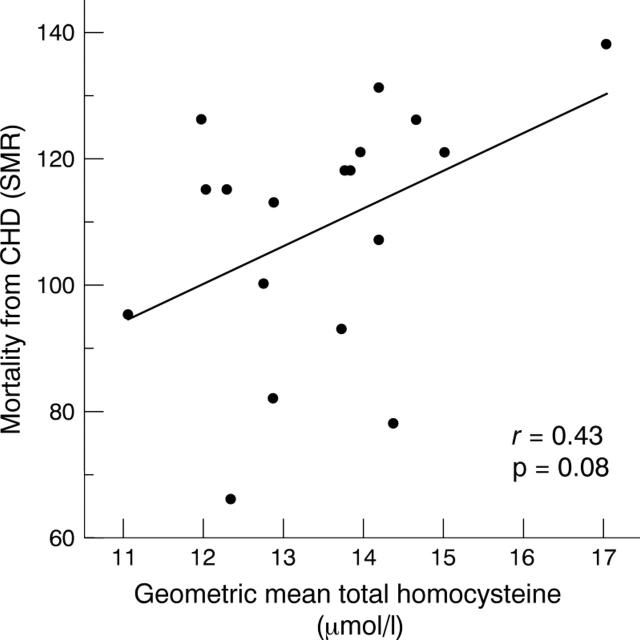Abstract
OBJECTIVES—To examine the prospective relation between total homocysteine and major coronary heart disease events. DESIGN—A nested case-control study carried out within the British regional heart study, a prospective investigation of cardiovascular disease in men aged 40-59 years at entry. Serum total homocysteine concentrations were analysed retrospectively and blindly in baseline samples from 386 cases who had a myocardial infarct during 12.8 years of follow up and from 454 controls, frequency matched by age and town. RESULTS—Geometric mean serum total homocysteine was slightly higher in cases (14.2 µmol/l) than in controls (13.5 µmol/l), a proportional difference of 5.5% (95% confidence interval (CI) −0.02% to 10.8%, p = 0.06). Age adjusted risk of myocardial infarction increased weakly with log total homocysteine concentration; a 1 SD increase in log total homocysteine (equivalent to a 47% increase in total homo cysteine) was associated with an increase in odds of myocardial infarction of 1.15 (95% CI 1.00 to 1.32; p = 0.05). The relation was particularly marked in the top fifth of the total homocysteine distribution (values >16.5 µmol/l), which had an odds ratio of 1.77 (95% CI 1.28 to 2.42) compared with lower levels. Adjustment for other risk factors had little effect on these findings. Total homocysteine concentrations more than 16.5 µmol/l accounted for 13% of the attributable risk of myocardial infarction in this study population. Serum total homocysteine among control subjects varied between towns and was correlated with town standardised mortality ratios for coronary heart disease (r = 0.43, p = 0.08). CONCLUSIONS—Serum total homocysteine is prospectively related to increased coronary risk and may also be related to geographical variation in coronary risk within Britain. These results strengthen the case for trials of total homocysteine reduction with folate. Keywords: coronary heart disease; homocysteine; epidemiology
Full Text
The Full Text of this article is available as a PDF (113.1 KB).
Figure 1 .
Cumulative frequency plot showing the distribution of total homocysteine concentrations among cases and controls.
Figure 2 .
Geometric mean total serum homocysteine in control subjects and standardised mortality ratios (SMR) for ischaemic heart disease (men 35-64 years, 1979-1983), by town.
Selected References
These references are in PubMed. This may not be the complete list of references from this article.
- Alfthan G., Aro A., Gey K. F. Plasma homocysteine and cardiovascular disease mortality. Lancet. 1997 Feb 8;349(9049):397–397. doi: 10.1016/S0140-6736(97)80014-1. [DOI] [PubMed] [Google Scholar]
- Alfthan G., Pekkanen J., Jauhiainen M., Pitkäniemi J., Karvonen M., Tuomilehto J., Salonen J. T., Ehnholm C. Relation of serum homocysteine and lipoprotein(a) concentrations to atherosclerotic disease in a prospective Finnish population based study. Atherosclerosis. 1994 Mar;106(1):9–19. doi: 10.1016/0021-9150(94)90078-7. [DOI] [PubMed] [Google Scholar]
- Arnesen E., Refsum H., Bønaa K. H., Ueland P. M., Førde O. H., Nordrehaug J. E. Serum total homocysteine and coronary heart disease. Int J Epidemiol. 1995 Aug;24(4):704–709. doi: 10.1093/ije/24.4.704. [DOI] [PubMed] [Google Scholar]
- Bates C. J., Mansoor M. A., van der Pols J., Prentice A., Cole T. J., Finch S. Plasma total homocysteine in a representative sample of 972 British men and women aged 65 and over. Eur J Clin Nutr. 1997 Oct;51(10):691–697. doi: 10.1038/sj.ejcn.1600468. [DOI] [PubMed] [Google Scholar]
- Bostom A. G., Lathrop L. Hyperhomocysteinemia in end-stage renal disease: prevalence, etiology, and potential relationship to arteriosclerotic outcomes. Kidney Int. 1997 Jul;52(1):10–20. doi: 10.1038/ki.1997.298. [DOI] [PubMed] [Google Scholar]
- Boushey C. J., Beresford S. A., Omenn G. S., Motulsky A. G. A quantitative assessment of plasma homocysteine as a risk factor for vascular disease. Probable benefits of increasing folic acid intakes. JAMA. 1995 Oct 4;274(13):1049–1057. doi: 10.1001/jama.1995.03530130055028. [DOI] [PubMed] [Google Scholar]
- Brattström L., Lindgren A., Israelsson B., Andersson A., Hultberg B. Homocysteine and cysteine: determinants of plasma levels in middle-aged and elderly subjects. J Intern Med. 1994 Dec;236(6):633–641. doi: 10.1111/j.1365-2796.1994.tb00856.x. [DOI] [PubMed] [Google Scholar]
- Chasan-Taber L., Selhub J., Rosenberg I. H., Malinow M. R., Terry P., Tishler P. V., Willett W., Hennekens C. H., Stampfer M. J. A prospective study of folate and vitamin B6 and risk of myocardial infarction in US physicians. J Am Coll Nutr. 1996 Apr;15(2):136–143. doi: 10.1080/07315724.1996.10718578. [DOI] [PubMed] [Google Scholar]
- Cook D. G., Shaper A. G., MacFarlane P. W. Using the WHO (Rose) angina questionnaire in cardiovascular epidemiology. Int J Epidemiol. 1989 Sep;18(3):607–613. doi: 10.1093/ije/18.3.607. [DOI] [PubMed] [Google Scholar]
- Danesh J., Lewington S. Plasma homocysteine and coronary heart disease: systematic review of published epidemiological studies. J Cardiovasc Risk. 1998 Aug;5(4):229–232. [PubMed] [Google Scholar]
- Egerton W., Silberberg J., Crooks R., Ray C., Xie L., Dudman N. Serial measures of plasma homocyst(e)ine after acute myocardial infarction. Am J Cardiol. 1996 Apr 1;77(9):759–761. doi: 10.1016/s0002-9149(97)89213-2. [DOI] [PubMed] [Google Scholar]
- Evans R. W., Shaten B. J., Hempel J. D., Cutler J. A., Kuller L. H. Homocyst(e)ine and risk of cardiovascular disease in the Multiple Risk Factor Intervention Trial. Arterioscler Thromb Vasc Biol. 1997 Oct;17(10):1947–1953. doi: 10.1161/01.atv.17.10.1947. [DOI] [PubMed] [Google Scholar]
- Fiskerstrand T., Refsum H., Kvalheim G., Ueland P. M. Homocysteine and other thiols in plasma and urine: automated determination and sample stability. Clin Chem. 1993 Feb;39(2):263–271. [PubMed] [Google Scholar]
- Gudnason V., Stansbie D., Scott J., Bowron A., Nicaud V., Humphries S. C677T (thermolabile alanine/valine) polymorphism in methylenetetrahydrofolate reductase (MTHFR): its frequency and impact on plasma homocysteine concentration in different European populations. EARS group. Atherosclerosis. 1998 Feb;136(2):347–354. doi: 10.1016/s0021-9150(97)00237-2. [DOI] [PubMed] [Google Scholar]
- Israelsson B., Brattström L., Refsum H. Homocysteine in frozen plasma samples. A short cut to establish hyperhomocysteinaemia as a risk factor for arteriosclerosis? Scand J Clin Lab Invest. 1993 Aug;53(5):465–469. doi: 10.3109/00365519309092541. [DOI] [PubMed] [Google Scholar]
- Nygård O., Nordrehaug J. E., Refsum H., Ueland P. M., Farstad M., Vollset S. E. Plasma homocysteine levels and mortality in patients with coronary artery disease. N Engl J Med. 1997 Jul 24;337(4):230–236. doi: 10.1056/NEJM199707243370403. [DOI] [PubMed] [Google Scholar]
- Nygård O., Vollset S. E., Refsum H., Stensvold I., Tverdal A., Nordrehaug J. E., Ueland M., Kvåle G. Total plasma homocysteine and cardiovascular risk profile. The Hordaland Homocysteine Study. JAMA. 1995 Nov 15;274(19):1526–1533. doi: 10.1001/jama.1995.03530190040032. [DOI] [PubMed] [Google Scholar]
- Pancharuniti N., Lewis C. A., Sauberlich H. E., Perkins L. L., Go R. C., Alvarez J. O., Macaluso M., Acton R. T., Copeland R. B., Cousins A. L. Plasma homocyst(e)ine, folate, and vitamin B-12 concentrations and risk for early-onset coronary artery disease. Am J Clin Nutr. 1994 Apr;59(4):940–948. doi: 10.1093/ajcn/59.4.940. [DOI] [PubMed] [Google Scholar]
- Perry I. J., Refsum H., Morris R. W., Ebrahim S. B., Ueland P. M., Shaper A. G. Prospective study of serum total homocysteine concentration and risk of stroke in middle-aged British men. Lancet. 1995 Nov 25;346(8987):1395–1398. doi: 10.1016/s0140-6736(95)92407-8. [DOI] [PubMed] [Google Scholar]
- Perry I. J. Serum total homocysteine concentration and risk of stroke. Lancet. 1996 Nov 30;348(9040):1526–1526. doi: 10.1016/s0140-6736(05)65956-9. [DOI] [PubMed] [Google Scholar]
- Phillips A. N., Shaper A. G., Pocock S. J., Walker M., Macfarlane P. W. The role of risk factors in heart attacks occurring in men with pre-existing ischaemic heart disease. Br Heart J. 1988 Nov;60(5):404–410. doi: 10.1136/hrt.60.5.404. [DOI] [PMC free article] [PubMed] [Google Scholar]
- Refsum H., Ueland P. M., Nygård O., Vollset S. E. Homocysteine and cardiovascular disease. Annu Rev Med. 1998;49:31–62. doi: 10.1146/annurev.med.49.1.31. [DOI] [PubMed] [Google Scholar]
- Refsum H., Ueland P. M., Svardal A. M. Fully automated fluorescence assay for determining total homocysteine in plasma. Clin Chem. 1989 Sep;35(9):1921–1927. [PubMed] [Google Scholar]
- Selhub J., Jacques P. F., Wilson P. W., Rush D., Rosenberg I. H. Vitamin status and intake as primary determinants of homocysteinemia in an elderly population. JAMA. 1993 Dec 8;270(22):2693–2698. doi: 10.1001/jama.1993.03510220049033. [DOI] [PubMed] [Google Scholar]
- Shaper A. G., Pocock S. J., Walker M., Cohen N. M., Wale C. J., Thomson A. G. British Regional Heart Study: cardiovascular risk factors in middle-aged men in 24 towns. Br Med J (Clin Res Ed) 1981 Jul 18;283(6285):179–186. doi: 10.1136/bmj.283.6285.179. [DOI] [PMC free article] [PubMed] [Google Scholar]
- Shaper A. G., Pocock S. J., Walker M., Phillips A. N., Whitehead T. P., Macfarlane P. W. Risk factors for ischaemic heart disease: the prospective phase of the British Regional Heart Study. J Epidemiol Community Health. 1985 Sep;39(3):197–209. doi: 10.1136/jech.39.3.197. [DOI] [PMC free article] [PubMed] [Google Scholar]
- Shaper A. G., Wannamethee G., Weatherall R. Physical activity and ischaemic heart disease in middle-aged British men. Br Heart J. 1991 Nov;66(5):384–394. doi: 10.1136/hrt.66.5.384. [DOI] [PMC free article] [PubMed] [Google Scholar]
- Stampfer M. J., Malinow M. R. Can lowering homocysteine levels reduce cardiovascular risk? N Engl J Med. 1995 Feb 2;332(5):328–329. doi: 10.1056/NEJM199502023320511. [DOI] [PubMed] [Google Scholar]
- Stampfer M. J., Malinow M. R., Willett W. C., Newcomer L. M., Upson B., Ullmann D., Tishler P. V., Hennekens C. H. A prospective study of plasma homocyst(e)ine and risk of myocardial infarction in US physicians. JAMA. 1992 Aug 19;268(7):877–881. [PubMed] [Google Scholar]
- Ueland P. M., Refsum H. Plasma homocysteine, a risk factor for vascular disease: plasma levels in health, disease, and drug therapy. J Lab Clin Med. 1989 Nov;114(5):473–501. [PubMed] [Google Scholar]
- Verhoef P., Stampfer M. J., Rimm E. B. Folate and coronary heart disease. Curr Opin Lipidol. 1998 Feb;9(1):17–22. doi: 10.1097/00041433-199802000-00005. [DOI] [PubMed] [Google Scholar]
- Wald N. J., Watt H. C., Law M. R., Weir D. G., McPartlin J., Scott J. M. Homocysteine and ischemic heart disease: results of a prospective study with implications regarding prevention. Arch Intern Med. 1998 Apr 27;158(8):862–867. doi: 10.1001/archinte.158.8.862. [DOI] [PubMed] [Google Scholar]
- Wannamethee G., Shaper A. G. Haematocrit: relationships with blood lipids, blood pressure and other cardiovascular risk factors. Thromb Haemost. 1994 Jul;72(1):58–64. [PubMed] [Google Scholar]
- Whincup P. H., Mendall M. A., Perry I. J., Strachan D. P., Walker M. Prospective relations between Helicobacter pylori infection, coronary heart disease, and stroke in middle aged men. Heart. 1996 Jun;75(6):568–572. doi: 10.1136/hrt.75.6.568. [DOI] [PMC free article] [PubMed] [Google Scholar]
- den Heijer M., Koster T., Blom H. J., Bos G. M., Briet E., Reitsma P. H., Vandenbroucke J. P., Rosendaal F. R. Hyperhomocysteinemia as a risk factor for deep-vein thrombosis. N Engl J Med. 1996 Mar 21;334(12):759–762. doi: 10.1056/NEJM199603213341203. [DOI] [PubMed] [Google Scholar]
- von Eckardstein A., Malinow M. R., Upson B., Heinrich J., Schulte H., Schönfeld R., Köhler E., Assmann G. Effects of age, lipoproteins, and hemostatic parameters on the role of homocyst(e)inemia as a cardiovascular risk factor in men. Arterioscler Thromb. 1994 Mar;14(3):460–464. doi: 10.1161/01.atv.14.3.460. [DOI] [PubMed] [Google Scholar]




